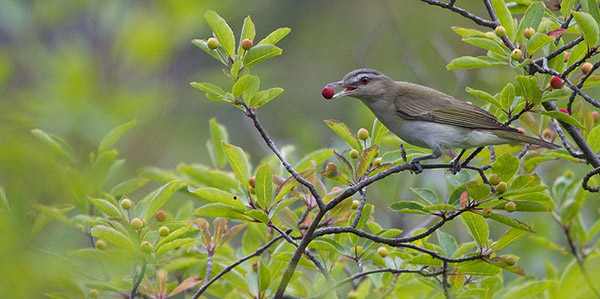Earlier this week I pointed out that urban areas can actually increase tree cover over time, albeit with a caveat. The two studies I cited measured tree cover and only tree cover—they made no claims about ecological function. Luckily, other studies have done just that, including one that looked at migratory bird use of greenways in urban areas.
Migratory routes are important, though most research into migratory bird decline has focused on habitat loss in their breeding and wintering grounds. That has left a large piece of the puzzle unsolved—the habitat between point A and point B. Think of it this way: If snowbirds—you know, northern (human) retirees who flock to warmer climes in the winter—started disappearing and our best solution was to look for them at their apartment in New York or their rental in Boca Raton—ignoring rest stops and motels along I-95—we’d be doing a great disservice to our older generations. Ignoring flyways is similarly foolish.
There have been studies in more recent years that aim to fill this gap, and one published in 2009 by Salina Kohut, George Hess, and Christopher Moorman picks up the trail along, well, trails. They surveyed bird species abundance and richness—how many and how varied the itinerants were—in 47 greenways in and around Raleigh, North Carolina.
Greenways are a common and convenient way for cities to conserve natural habitat. Their linear form is well suited to urban areas, and they easily double as parks or recreational trails. They also can serve as stop-over habitat for migratory birds. Kohut, Hess, and Moorman were hoping to find the right type of corridor for migrating birds, where our feathered friends can take a load off and fatten up.
It turns out that most birds were not picky and would stop at just about any greenway, regardless of vegetation, adjacent land use, or corridor width. That’s not to say all greenways were entirely equal. Overall, birds favored corridors with taller trees and lots of native shrubs teeming with fruit. And among birds that live in forest interiors far away from human development and even open fields, greenways wider than 150 meters (about 500 feet) surrounded by low-intensity development were the most popular.
None of the greenways Kohut and her colleagues studied were as good as a regular forest, though. Still, with some tweaks—including widening corridors, siting them near low-intensity development, and planting with natives—greenways can make decent stand-ins for the real thing, at least as far as migratory birds are concerned. Residential neighborhoods can even make themselves into agreeable stopover habitat by mimicking vegetation found at popular stops along the flyway.
So greenways make for good bird habitat, but let’s not forget that they’re good neighbors, too. In addition to helping migrating fauna, they boost property values, add recreational opportunities, and work well as commuting corridors for cyclists. Five benefits from one land use. Not too shabby.
Photo by qmnonic.
Source:
Kohut, S., Hess, G., & Moorman, C. (2009). Avian use of suburban greenways as stopover habitat Urban Ecosystems, 12 (4), 487-502 DOI: 10.1007/s11252-009-0099-6
Related posts:
